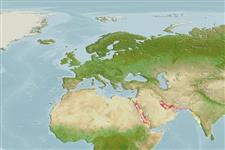Klassifizierung / Names
Namen | Synonyme | Catalog of Fishes(Gattung, Arten) | ITIS | CoL | WoRMS | Cloffa
>
Eupercaria/misc (Various families in series Eupercaria) >
Labridae (Wrasses) > Corinae
Etymology: Macropharyngodon: Greek, makros = great + Greek, pharyngx = pharynx + Greek,odous = teeth (Ref. 45335).
More on author: Randall.
Environment: milieu / climate zone / depth range / distribution range
Ökologie
seewasser riff-verbunden; standorttreu; tiefenbereich 4 - 16 m. Tropical
Western Indian Ocean: Red Sea.
Size / Gewicht / Alter
Maturity: Lm ? range ? - ? cm
Max length : 9.5 cm SL Männchen/unbestimmt; (Ref. 2694)
Kurzbeschreibung
Morphologie | Morphometrie
Rückenflossenstacheln (insgesamt): 9; Rückenflossenweichstrahlen (insgesamt): 11; Afterflossenstacheln 3; Afterflossenweichstrahlen: 11. This species is distinguished by the following characters: D IX,11; A III,11; pectoral rays 12 (including upper rudimentary ray); complete lateral line, angling downward below last 3 or 4 dorsal rays to straight peduncular portion, 27 pored scales (plus 1 on base of caudal fin); anterior lateral-line scales with 2 or 3 (rarely 4) pores; gill rakers 14-17; body depth 2.6-2.9 in SL; head length (HL) 2.95-3.05 in SL; snout short, 3.3-3.7 in HL; upper jaw with 2 pairs of canine teeth, 1st pair straight and strongly projecting anteriorly, 2nd pair about two-thirds as long, with tips recurved and outflaring; lower jaw with a medial pair of long, straight, forward-jutting, canine teeth, each with an adjacent more slender canine about two-thirds as long, with recurved tip; side of jaws with single row of close-set conical teeth, progressively shorter posteriorly; a very large, slender, forward-projecting, canine tooth posteriorly on upper jaw; lower pharyngeal plate with an enormous central molariform tooth, on each side anteriorly with a row of small conical teeth, continuing as a single row on the long anterior process; each of the pair of upper pharyngeal plates with 2 large, nearly square molars, preceded by a patch of small stout conical teeth; orbit diameter 4.25-4.95 in HL; origin of dorsal fin slightly anterior to a vertical at upper end of gill opening; first dorsal spine 4.25-5.25 in HL; remaining spines progressively longer, 9th 3.1-3.25 in HL; 5th or 6th dorsal soft ray longest, 1.9-2.2 in HL; 3rd anal spine longest, 2.45-3.55 in HL; 5th or 6th anal soft ray longest, 1.95-2.2 in HL; caudal fin slightly rounded, 1.2-1.3 in HL; pectoral fins 1.4-1.5 in HL; pelvic fins 1.35-1.8 in HL, usually reaching to or slightly posterior to origin of anal fin in mature males, usually not reaching anus in females (Ref. 93522).
Life cycle and mating behavior
Geschlechtsreife | Fortpflanzung | Ablaichen | Eier | Fecundity | Larven
Oviparous, distinct pairing during breeding (Ref. 205).
Randall, J.E., 2013. Seven new species of labrid fishes (Coris, Iniistius, Macropharyngodon, Novaculops, and Pteragogus) from the Western Indian Ocean. J. Ocean Sci. Found. 7:1-43. (Ref. 93522)
IUCN Rote Liste Status (Ref. 130435)
Bedrohung für Menschen
Harmless
Nutzung durch Menschen
Mehr Information
Alter/GrößeWachstumLänge-GewichtLänge-LängeLängenhäufigkeitenMorphometrieMorphologieLarvenLarven Pop.Dyn.RekrutierungDichteBRUVS
ReferenzenAquakulturAquakultur ProfilZuchtlinienGenetikElectrophoresesVererbbarkeitKrankheitenVerarbeitungNutrientsMass conversion
PartnerBilderStamps, Coins Misc.LauteCiguateraGeschwindigkeitSchwimmstilKiemenoberflächeOtolithsGehirngrößeSehfähigkeit
Tools
Zusatzinformationen
Download XML
Internet Quellen
Estimates based on models
Preferred temperature (Ref.
123201): 24.6 - 29.3, mean 27.5 °C (based on 183 cells).
Phylogenetic diversity index (Ref.
82804): PD
50 = 0.5002 [Uniqueness, from 0.5 = low to 2.0 = high].
Bayesian length-weight: a=0.01995 (0.00906 - 0.04395), b=3.01 (2.83 - 3.19), in cm total length, based on all LWR estimates for this body shape (Ref.
93245).
Trophic level (Ref.
69278): 3.5 ±0.4 se; based on size and trophs of closest relatives
Widerstandsfähigkeit (Ref.
120179): hoch, Verdopplung der Population dauert weniger als 15 Monate. (Preliminary K or Fecundity.).
Fishing Vulnerability (Ref.
59153): Low vulnerability (10 of 100).
Nutrients (Ref.
124155): Calcium = 115 [56, 202] mg/100g; Iron = 0.782 [0.386, 1.575] mg/100g; Protein = 18.1 [15.2, 20.4] %; Omega3 = 0.125 [0.071, 0.214] g/100g; Selenium = 19.9 [10.4, 40.6] μg/100g; VitaminA = 125 [33, 637] μg/100g; Zinc = 1.66 [1.05, 2.79] mg/100g (wet weight);
